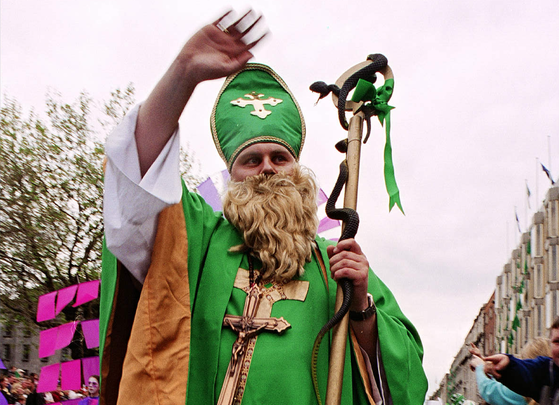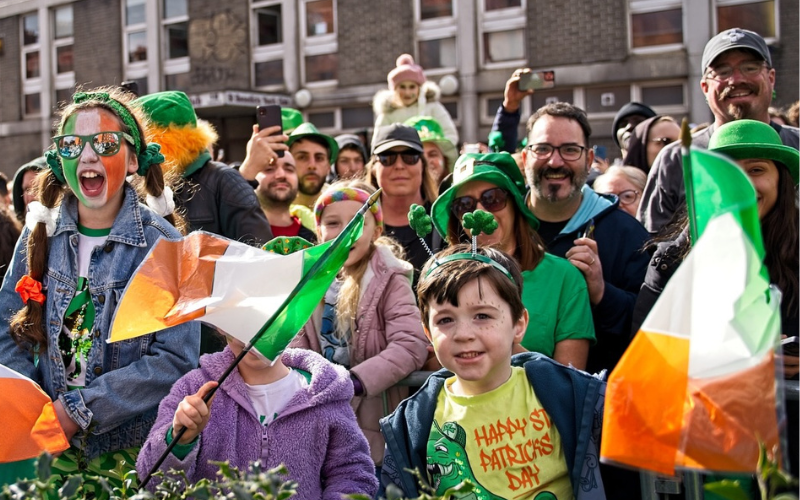Beer, clothes, monuments, and even rivers will turn green to celebrate St. Patrick’s Day, but did you know that green wasn’t always a color associated with Ireland's patron saint?
What was St. Patrick’s original color?
Patrick was first represented by the color blue. This 13th-century image of St. Patrick depicts Ireland's patron saint in a blue robe.
Why was St. Patrick’s original color blue?
The earliest depictions of St. Patrick show him clothed in blue garments, not green.
When George III was King of Great Britain and Ireland, he created a new order of chivalry for the Kingdom of Ireland, called the "Order of St. Patrick."
The order was founded in 1783, a year after the grant of substantial autonomy to Ireland, as a means of rewarding (or obtaining) political support in the Irish Parliament. Its official color was a sky blue, known as "St. Patrick's Blue."
Where did the color blue originate from in Irish history?
The significance of blue dates back to early Irish mythology when the sovereignty of Ireland, "Flaitheas Éireann," was often represented by a woman dressed in a blue robe.
The depiction is believed to be based on the 10th-century queen Gormfhlaith, a portmanteau of the ancient Irish words for blue (gorm) and sovereign (flaith).
When did Ireland first start using the color blue?
The first formal use of the color blue was under the reign of King Henry VIII who turned Ireland into a Kingdom in 1542.
Henry – who was the Lord of Ireland at the time – split from Catholicism and set up his own Church of England, bringing Ireland with him and declaring it a separate Kingdom.
The formal creation of a new Kingdom meant Ireland was granted its own coat of arms – a golden harp placed on a blue background.
When George III created a new order of chivalry for the Kingdom of Ireland he needed to adopt a color for it.
The Order of the Garter for the previous Kingdom of England already used a dark blue (Scotland’s Order of the Thistle used green) so a lighter blue was used for the Order of St Patrick. This blue became known as "St Patrick’s Blue."
This is also the reason Dublin GAA county teams wear a light blue and the University College of Dublin (UCD) sports teams play in St Patrick’s Blue and saffron.
Where did the color green come from?
The use of the color green with Ireland has been an evolution over time.
It is popularly believed that St. Patrick once used a shamrock in his preaching to symbolize the Christian Holy Trinity, although the first written account of this does not appear until Caleb Threlkeld wrote about it in 1726.
Derived from the Irish word "seamróg," meaning "little clover," shamrock refers to young sprigs of clover.
During the 1798 Irish Rebellion, the clover became a symbol of nationalism and the "wearing of the green" on lapels became a regular practice. The green soon spread to uniforms as well.

Celebrate everything Irish this March with IrishCentral's global community.
The term “The Emerald Isle” is synonymous with Ireland and its rolling hills and vales of green. The term dates back to a poem by Belfast-born William Drennan, titled “When Erin First Rose," which he penned in 1795.
That evolution, combined with the idea of Ireland's lush green fields, eventually made blue a thing of the past.
Now, every year on St. Patrick's Day, the Irish Taoiseach presents a Waterford crystal bowl featuring a shamrock design containing shamrocks to the US President in the White House.
What is Ireland’s official national color?
Ireland's Constitution defines the green-white-orange tricolor as the national flag, but doesn’t define a national color so, in essence, Ireland doesn’t have an official national color!
In fact, copies of the Irish Constitution (Bunreacht na hÉireann) are printed with a blue cover and the carpets of the Irish Houses of Parliament are a deep blue.
* Originally published in 2019, updated in March 2025.




Comments